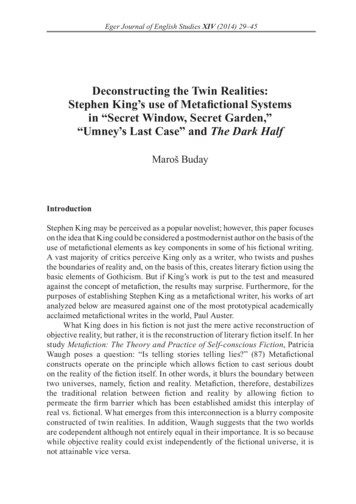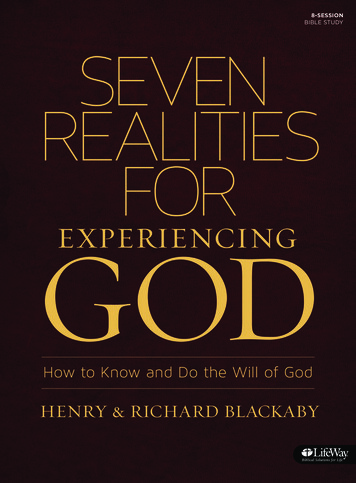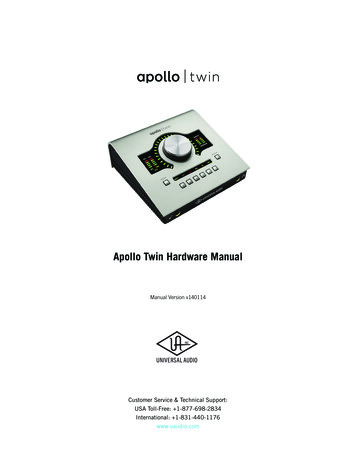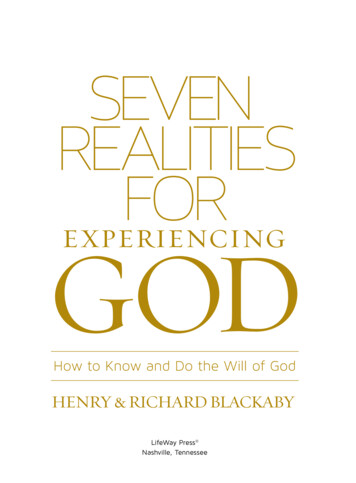
Transcription
Eger Journal of English Studies XIV (2014) 29–45Deconstructing the Twin Realities:Stephen King’s use of Metafictional Systemsin “Secret Window, Secret Garden,”“Umney’s Last Case” and The Dark HalfMaroš BudayIntroductionStephen King may be perceived as a popular novelist; however, this paper focuseson the idea that King could be considered a postmodernist author on the basis of theuse of metafictional elements as key components in some of his fictional writing.A vast majority of critics perceive King only as a writer, who twists and pushesthe boundaries of reality and, on the basis of this, creates literary fiction using thebasic elements of Gothicism. But if King’s work is put to the test and measuredagainst the concept of metafiction, the results may surprise. Furthermore, for thepurposes of establishing Stephen King as a metafictional writer, his works of artanalyzed below are measured against one of the most prototypical academicallyacclaimed metafictional writes in the world, Paul Auster.What King does in his fiction is not just the mere active reconstruction ofobjective reality, but rather, it is the reconstruction of literary fiction itself. In herstudy Metafiction: The Theory and Practice of Self-conscious Fiction, PatriciaWaugh poses a question: “Is telling stories telling lies?” (87) Metafictionalconstructs operate on the principle which allows fiction to cast serious doubton the reality of the fiction itself. In other words, it blurs the boundary betweentwo universes, namely, fiction and reality. Metafiction, therefore, destabilizesthe traditional relation between fiction and reality by allowing fiction topermeate the firm barrier which has been established amidst this interplay ofreal vs. fictional. What emerges from this interconnection is a blurry compositeconstructed of twin realities. In addition, Waugh suggests that the two worldsare codependent although not entirely equal in their importance. It is so becausewhile objective reality could exist independently of the fictional universe, it isnot attainable vice versa.
30 Maroš BudayThis article deals with the fact that Stephen King not only reweaves realitybut also deconstructs fiction. In terms of Waugh, the reality which is the truthbecomes level with fiction which initially, as non-metafictional literature exhibits,bares the properties of the lie and, in King’s hands, becomes the truth. King, aswell as other postmodernist writers, in some cases, explores and what is moreimportant to this context undermines his own position as a writer. He does soby the means of metafiction. In combination with his unique talent to pierce theveil of human consciousness to find phobic pressure points where fear, as one ofthe strongest human emotions, lies, his metafictional writing becomes somewhatdifferent.King completely ignores traditional forms of metafiction and instead ofthem he offers his readers entirely singular metafictional systems. Ranging fromfused traditional forms of metafiction to entirely unorthodox and novel ones,King achieves not only the complete reinvention of the genre of horror fictionbut of the novel itself. It is because his approach is so non-traditional and is quitedisjointed from postmodernist literary conventions, that new terminology has tobe introduced into Waugh’s traditional forms of metafiction (the self-begettingnovel, surfiction and fabulation being the most prominent ones). This chapteranalyzes three of King’s most prototypical metafictional novels which fall intothree distinct categories, namely psychogenic metafiction (“Secret Window,Secret Garden”), transpositional metafiction (“Umney’s Last Case”) and corporealmetaficion (The Dark Half ).All of these three novels operate on postmodernist literary conventions butthey principally differ from one another, hence the categories. What they have incommon though, is that they all deal with reality and fiction, truth and ‘lies,’ andthey do that by addressing both as one and the same. Because writing comes fromtruth, as Stephen King emphasized when delivering his acceptance speech to theThe National Book Foundation’s Medal for Distinguished Contribution to AmericanLetters, by saying that “we understand fiction is a lie to begin with. To ignorethe truth inside the lie is to sin against the craft, in general, and one’s own workin particular” (King, “Stephen King”). What King very aptly points out is that,while he acknowledges that literary fiction is grounded in imagination it operateson principles of truth which are grounded in reality as perceived by the author.This very statement which predicates that there is truth within the mediumof fiction is the reason for Stephen King’s decision to have written these threeunique, horrifying and strangely rational, yet becoming pieces of writing. As heputs it, “I never truckled, I never lied. I told the truth. And that’s always been thebottom line for me. The story and the people in them may be make-believe but Ihave to ask myself over and over if I’ve told the truth” (King, “Stephen King”).
Of National Bondage: Alasdair Gray’s 31Psychogenic MetafictionIn the preface to one of King’s most complex psychological metafictional pieces“Secret Window, Secret Garden”, he comments on the process of making notonly this particular novelette, but also the construction of fiction in general. Hedeclares that he got the idea for this novelette when looking out of an upstairslaundry room window and seeing a small abandoned garden. He quickly makesthe experience into an elaborate metaphor by saying thatIt’s an area [the garden] I see just about every day but [thistime] the angle was new. The phrase which occurred to mewas, of course, the title of this story. It seemed to me as gooda metaphor for what writers – especially writers of fantasy –do with their days and nights. Sitting down at the typewriteror picking up a pencil is a physical act; the spiritual analogueis looking out of an almost forgotten window [ ] a windowwhich offers a common view from entirely different angle[ ] an angle which renders the common extraordinary. Thewriter’s job is to gaze through that window and report on whathe sees. But sometimes windows break. I think that, morethan anything else, is the concern of this story: what happensto the wide-eyed observer when the window between realityand unreality breaks and the glass begins to fly? (King 2)For King, the act of writing is an art, but what is more important here is thestatement which King tries to make, not only of this story, but of the art itself.What King emphasizes here is that the window, therefore, the writer’s psycheconstitutes a lens through which reality is perceived. The truth becomes a liewhen it is engaged and explored in written discourse. The question he poses atthe end completely destabilizes this traditional literary notion and explores deeperconcerns. When a window, i.e. the writer’s psyche breaks, the consequences arepotentially destructive, which is exactly what the theme of “Secret Window,Secret Garden” is about.In the context of metafictional practice though, the metaphor deepens evenfarther. The sole fabric of reality is called into question. Therefore, we couldtransform King’s question into the following form: What happens to an observerwhen the barrier between reality and literary fiction is either thin or simplydisappears? This is also one of the themes which are hidden within the story itself.The observer becomes the reader who, if he or she realizes the truth behind thefiction, comes to question not only the plot or the stories’ characters but the writtenartifact itself. The reader thus notices the connections, the pressure points whichdraw objective reality into the work of fiction which destabilizes and underminesthe fiction itself, which renders it obsolete. The fiction than becomes a hybrid,
32 Maroš Budaya metafictional text, which has the properties of both reality and fiction alike. Thereaders’ realization that the story has strong ties not only to particular objects ofextralinguistic reality but also in reference to itself as a work of fiction is the artof metafiction par excellence. And it is exactly what King in this novelette does.“Secret Window, Secret Garden” explores the psyche and the psyche-inducedactions of a mentally traumatized writer called Morton Rainey. The mental traumawhich his main character endures is induced by Rainey catching his beloved wifein bed with her lover, with whom she, after filing for divorce, engages in a romanticrelationship. The story begins several months after this incident with MortonRainey living alone in a lake house in Maine. At the beginning of the story themain character is visited by the antagonist of the story called John Shooter, whoimmediately accuses Rainey of plagiarism and claims that he has stolen his storyand the only thing he wants from Rainey is for him to fix the ending to his story.Rainey automatically rejects the accusation. It turns out that Rainey’s story called“Sowing Season” and Shooter’s story called “Secret Window, Secret Garden”, arenearly identical, after which Shooter proposes a three day ultimatum. If Raineycan deliver proof that he has written the story before Shooter, than he backs off.During the three day period, the protagonist is under a great deal of stress motivatedby Shooter. Shooter’s attacks gradually escalate and are realized by him killingRainey’s cat with a screwdriver, burning down his former house as well as killinghis friend and handy man. What is particularly noteworthy is that the handy manis the only one who went by when Rainey and Shooter were having a conversationoutside the lake house and subsequently claimed that Rainey was there by himself.After the death of the handy man, it becomes apparent that something is amiss inthe story. Shooter has a conversation with Rainey where he acknowledges that heis only a reflection of his psyche: nothing more than a mere manifestation of hisdisturbed unconscious mind. It turns out that Rainey’s psychological trauma hasrun a lot deeper than he was willing to admit to himself. The anger and frustrationresulting from his inadequacy in maintaining a functional relationship with hiswife has taken its toll and caused Rainey’s malformed psyche to invent a wholenew persona – John Shooter.The character of Shooter is constructed very elaborately. He is an embodimentof memorial fragments which had been transferred from Rainey’s consciousnessand embedded deep within his unconscious mind. Shooter is an older man witha southern accent, who comes from Mississippi and he wears a dark hat. Shooteris a combination of literary and cultural references, past and present events andacquaintances experienced and met by Rainey. He serves as both a blessing anda curse to him. Since Rainey’s superego, his conscience, is incapable of actingon his unconscious id (in this case his aggressive urges), he invents a personato do the bidding of his clearly prevailing id for him. Throughout the story,Rainey identifies with Shooter only partly at first, mainly through the medium ofwritten discourse, which plays a key role in the development of the protagonist’spsychological breakdown. Towards the end of the novelette, Shooter fully takes
Of National Bondage: Alasdair Gray’s 33over Rainey’s conscious mind and attempts to kill his wife and her lover. Rainey’sconsciousness basically subsides into the depths of his own psyche. The apparitionof Shooter becomes the driving force behind Rainey’s actions. It could be askedwhy, in case Shooter is a manifestation of Rainey’s subconscious mind, does hetorture him so much. In other words, how come Rainey’s subconscious mindallows his other persona to act aggressively against himself?Calling forth another persona seems to be a preemptive action. It appears tobe so due to the fact that the subconscious mind is the paragon of mental healthand protection. Although in Rainey’s case, it becomes counterproductive. It hasto create the other (Shooter) and destroy the original one. So, the aggressivebehavior of the other towards Rainey is an attempt of the subconscious mind,however unsuccessful, to harden the latter’s mental defenses while giving wayto the overeager id. The ineffectiveness of this subconscious action and the needfor unity of mind results in the prevalence of the other – in Darwinian terms, thefittest, who Shooter in this undoubtedly is, survives.The practice on metafiction in this novelette is apparent in several places andit can be found in several different forms. First of all, this story is a kind of a metametafiction because the primary metafiction is realized through the character ofRainey being a writer, which in itself is the undermining of the author’s status asthe looming shadow presence who has subtly presented dominant power over hisfiction. What is more interesting is the mixture of varieties of metafiction whichKing very carefully and deliberately uses in this novelette.What further destabilizes the narrative is King’s mastery of the 3rd personnarration which is in no way omniscient as it is a custom in this type of storytelling,but it rather adopts the position of the 1st person narration. The hybridization ofthe two most common types of narration results in a uniquely claustrophobicatmosphere. While the reader follows the account of Morton Rainey’s life from thepoint of view of third person, at the same time, he/she also suffers from the narrowviewpoint which is characterized by the story revolving only around the characterof Rainey. Furthermore, the reader is given only the information from the outsideworld, which encompasses objects of extralinguistic reality. The outside world inthis story is not only predicated on objective reality but rather Rainey’s consciousthoughts as well. The thoughts of the main character are presented alongsideobjective reality, thus rendering them a part of this reality. All of the metafictionalaspects of this story are bipolar, Platonic constructs; therefore, they are comprisedof two distinct worlds. In this case, it is the world which Rainey’s consciousnessexperiences as well as the consciousness itself. The other world constitutes theseemingly dormant and narratively implicit subconscious mind of Rainey andShooter as well. Regarding the employment of hybridization in narration in thisparticular novelette, the metafiction can be also seen in the property of the writtendiscourse reaching out to the reader, who cannot do anything but identify withthe main character. In other words, the world of truth and the world of lies mergetogether into one reality.
34 Maroš BudayAbove all metafictional aspects, the most important issue which this storybrings forth is the question of reality itself. As it was mentioned above, metafictionis grounded in the theory that there is only one real world which is comprised oftwo equally true realities, namely extralinguistic reality and literary fiction. Thesetwo worlds coincide and exist side by side and from time to time interact throughthe act of reading. What King achieves in “Secret Window, Secret Garden” isa kind of a nebulous state of reality, where dreams and reality merge into one worldwhere they interact. The two worlds are represented by Rainey’s subconscious(the center of dreams) and conscious mind (the center of the perception of reality).In the course of the story, Rainey tries tie remember several of the events andobjects of the extralinguistic reality which are somehow tied to his unconsciousinvention of the persona of Shooter. These memorial fragments are hard to recallbecause “his memory of the event [is] quite foggy” (43). Memories are veryimportant aspects of this story. The protagonist gradually begins to question theauthenticity of his own recollections. “Mort took no notice, confusing her [hiswife’s] real voice with the voice in his mind, which was the voice of a memory.But was it a true memory or a false one? That was the real question, wasn’t it? Itseemed like a true memory” (46). The confusion which the protagonist feels hereis a representation of the real and the textual world overlapping and starting toform a bridge between the two. Shooter, as an invented persona of a writer, andRainey start to become one and the same. Until the end of the story Shooter isonly a part of the non-textual discourse but it slowly becomes apparent that he isa part of the written discourse as well. When Rainey is visited by his estrangedwife towards the end of the story, what he hears in his conscious mind is the firstline of Shooter’s story “Secret Window, Secret Garden”, which is basically thesame as his story – “Sowing Season”: “She had stolen his love, and a womanwho would steal your love when your love was really all you had to give was notmuch of a woman” (99). This is the point of the story when not only John Shooterand Morton Rainey become one whole persona but it also becomes clear thatboth stories transform into one. The textual information presented in the storyseeps into Rainey’s reality, therefore, reality within the fiction, which furthercomplicates and mystifies the clear-cut boundary between truth and fiction withinthis narrative, i.e. the fiction as such. And because this form of metafictionalpractice is generated in the character’s psyche, the term psychogenic metafictionis appropriate.Another interesting metafictional aspect of this narrative is the layeredness offiction within the medium of fiction. First of all, there may be found fragments ofstories embedded within the narrative structure. But this metatextual informationis only the tip of the iceberg. When one looks at “Secret Window, Secret Garden”in terms of metafiction, one cannot omit the looming presence not only of theindividual layers of narrations but mainly of the complex matrix of characters whohad written the novelette “Secret Window, Secret Garden”. It is as much about theproducers of this written discourse as it is about the title of the story itself. Within
Of National Bondage: Alasdair Gray’s 35the context of this work of fiction, there are five distinct interconnected levels ofreality present and they all have a connection to the title of the narrative. Firstly,“Secret Window, Secret Garden” is the name of the story which, as a young man,Morton Rainey plagiarized from his classmate John Kintner. As years went byhe forgot about the incident and pushed the memory to his subconscious mind.Later, he published the story under the name “Sowing Season”. The narrative thenresurfaced in the form of John Shooter and again adopted the name of its formerimage.The last two layers of narration are especially interesting. At the very endof the story, after Morton Rainey is killed, his wife Amy finds a letter from JohnShooter. The letter says: “I am sorry for all the trouble. Things got out of hand.I am going back to my home now, I got my story, which is all I came for in the firstplace. Yours Truly. John Shooter” (112). When this letter is taken into account,it could be suggested that the story which is being read by the recipient – thereader, is the story which was written by John Shooter as the prime mover ofthis layered metafiction. Shooter thus takes the place of Stephen King himselfand acts as the writer while, Stephen King, being the last and final metafictionallayer, only establishes a shadow presence. But we may go a little further. The factthat John Shooter leaves a physical remnant of his presence in the literary worldsuggests that he himself as the author of the original novelette (the literary worldfrom which all subsequent literary worlds of this narrative emerge) performeda metafictional act by writing himself into the confines of the story.This narrative is unique in many ways but the most noteworthy is King’sability to blur the boundaries between the reader and the main character, MortonRainey. The true genius of this piece of writing, from a metafictional standpoint,lies in his ability to utterly and consciously undermine his own status as thecreator of this work of fiction by completely destroying the veil between realityand fiction, thus identifying himself with the character of John Shooter. Therefore,Stephen King abides by the general rules of metafictional practice to the letter.By merging two worlds not only in the setting or the plot but by making thecharacters, reader and the writer one and the same thing – one giant simulacrum,which is no less real than its constituents. The novelette “Secret Window, SecretGarden” ultimately denies the writer any escape from his imagination, whichdissolves the line between the real and the imagined rendering the writer theinsane God feared in Misery’s Return, a novel which the antagonist Annie Wilkesforced the main character Paul Sheldon, in King’s novel Misery, to create.Transpositional MetafictionIn Misery’s Return Sheldon writes: “His ideas about God had changed [ ] He haddiscovered that there was not one God but many, and some were more than cruel--they were insane, and that changed all. Cruelty, after all, was understandable.
36 Maroš BudayWith insanity, however, there was no arguing” (King, 310). This comment withinthe context of metafiction explores the multiplicity of worlds within other worlds.In this story King explicitly explores the power which the author exorcises andholds with respect to his creation. What this short excerpt from Misery statesis that authors stand in a god-like position in reference to the whole literaryuniverse, which encompasses space, time, plot and characters as well. When thefact that through metafiction, the literary universe is perceived equally realistic asobjective reality is taken to account, it could be said that writers, as the creators ofworlds parallel to this one, automatically assume a god-like status. As one of thebest known academically acclaimed authors of postmodernist fiction, Paul Austerwrites in his Travels in the Scriptorium towards the end of the narrative:It will never end. For Mr. Blank is one of us now, and strugglethough he might to understand his predicament, he will alwaysbe lost. I believe I speak for all his charges when I say he isgetting what he deserves—no more, no less. Not as a form ofpunishment, but as an act of supreme justice and compassion.Without him, we are nothing, but the paradox is that we, thefigments of another mind, will outlive the mind that made us,for once we are thrown into the world, we continue to existforever, and our stories go on being told, even after we aredead. (64)Firstly, this story is an account of one (and only one) day in the life of theprotagonist Mr. Blank, who relives this day over and over again. This excerpt isfrom the afterword to the story, the existence of which is credited to the name N.R.Fanshawe, a name of the character in another of Auster’s narratives called TheNew York Trilogy. Similarly to King’s implicit positioning of the character of JohnShooter into the position of the author, therefore himself, does Paul Auster creditand thus identifies himself with his own literary creation, Fanshawe. The literarycreations John Shooter and N.R. Fanshawe both assume the god-like position inwhich the author stands in relation to his own literary work, but at the same timethey both stand in a character-like position, as is more than apparent in the excerptfrom Auster’s Travels in the Scriptorium. The fact that Fanshawe is the explicitcreator of this piece and he also refers to himself in regards to Mr. Blank in thefirst person singular and plural as well, suggests the equality of the status of bothas mere literary creations of the prime mover, Paul Auster. There is one interestingelement which is not present in King’s novelette “Secret Window, Secret Garden”but is present in Auster’s narrative, and that is the seemingly insignificant statusof literary characters in association with the authors themselves. When we assumethe position that authors are in a god-like relation to their literary creations, weautomatically diminish the status of characters. But as Auster aptly points outin Travels in the Scriptorium, the characters of stories continue to exist forever.
Of National Bondage: Alasdair Gray’s 37Therefore, it could be stated that the original position, that characters are inferiorto their creators which has been dominant in literature until the emergence ofPostmodernism, is nowadays continually reversed. Literary characters thusassume the position of ethereal beings who, although they cannot exorcise powerover authors, in many cases, they definitely outlive their original makers. Thisis a concept which Stephen King deconstructs in another one of his prototypicalmetafictional pieces called “Umney’s Last Case”. This short story is analyzedhere in detail in parallel with Paul Auster’s themes incorporated in his New YorkTrilogy as well as Travels in the Scriptorium. It is due to the striking thematicsimilarities with Auster’s writing which King employs in his short story.“Umney’s Last Case” follows the story of a private eye in L.A., called ClydeUmney who on a completely ordinary day walks to work. During the walk henotices several unsettling changes in the environment which occur in events,places and characters in a previously perpetual state of existence, such as thenewsboy standing on the street corner every day not being there, his favorite barbeing closed, an elevator attendant having to retire after many years of servicein the building where Clyde has his office and many more. After stepping ofthe elevator at the floor where his office is located, he gets inexplicably agitatedat a group of painters painting the lobby. After a short squabble he learns thatthe building’s owner, called Samuel Landry, has given the order to repaint thelobby. Oddly, the name of the owner seems to be unknown to Clyde. The finalstraw is when he discovers that his secretary, Candy Cane, has left him a letterof resignation. In other words, Clyde’s relatively eventful yet monotonous lifebecomes dominated by chance, which is a concept previously alien to him.The phrase “confusion, confusion, nothing but confusion” (King 843) is beingfrequently repeated throughout the narrative. It becomes the central theme of thestory. Shortly after arriving at his office, he is visited by a man. Clyde’s reactiontakes him by surprise when he states:I was scared out of my mind. I’ve faced blazing guns in thehands of angry men, which is bad, and daggers in the handsof angry women, which is a thousand times worse [ ] I haveeven been tossed out of a third-story window. It’s been aneventful life, all right, but nothing in it had ever scared methe way the smell of that cologne and that footstep scared me.‘Clyde’ a voice said. A voice I’d never heard before, a voiceI nevertheless knew as well as my own. (845)Furthermore, Clyde grows a lot more concerned when he notices theappearance of the man sitting in his office. The man in the chair has featureswhich very closely resemble Clyde himself and as it turns out, the man looksexactly like Clyde apart from the age difference. The latter appears to be thespitting image of Clyde. After this unsettling encounter the two men talk a little
38 Maroš Budaylonger. The tone of the narrative abruptly shifts when the true purpose of the storybecomes apparent as is demonstrated by one of the most important subchaptersfound in the story. The title of this subchapter seems to be speaking for itself.This fifth subchapter is entitled “Interview with God” (847) which is aninteresting and quite apt choice of words because the man visiting Clyde introduceshimself as Samuel Landry. Landry gradually takes over the conversation andstates that he is the creator of Clyde and the world Clyde inhabits, in otherwords, he is a writer. It turns out that Clyde is the main character in a moderatelysuccessful detective series. Trying to persuade Clyde that he is telling the truth,Landry immediately presents several arguments, after which the former triesto attack him out of frustration. Landry assumes domination over the literarycharacter and stops Clyde’s advance by typing the actions of his character intohis laptop. This finally satisfies Clyde’s skepticism. Landry than comes clearover the real reason for plunging into his own creation – his literary world. As itappears, Landry’s life in reality has not been so kind to him. His son has died andconsequently, he and his wife got divorced. Furthermore, Landry suffers fromshingles, which is an incurable and painful disease. Thus the true motives ofClyde’s maker begin to take shape. Landry familiarizes Clyde with his intentionsin assuming his place in the literary world, where he believes he can be trulyhappy. Than without asking for Clyde’s consent Landry assumes the positionof the private eye, Clyde Umney and Clyde’s consciousness is transferred intoreality, therefore, Samuel Landry’s body.This elaborate form of metafiction is a combination of two traditional andone hybridized example of metafictional writing, namely the self-begetting novel,surfiction as well as the aforementioned hybridized form of metafiction previouslydescribed in the novelette “Secret Window, Secret Garden” – the multi-layeredmetafiction. It is so because of the transposition of characters, parallel worlds andof power interiorized within the position an author holds over his writing.Primarily, what is particularly striking about this short story is the complexand explicit manner in which King handles metafiction when it comes to thetranspositioning of two worlds – the “real” and the imaginary. As the character ofLandry points out “writers very rarely plunge all the way into the worlds they’vecreated, and when they do, they end up doing it strictly in their heads, whiletheir bodies vegetate in some mental asylum. Most of us are content simply to betourists in the country of our imaginations” (King, 862). What King very clearlya
Stephen King's use of Metafictional Systems in "Secret Window, Secret Garden," "Umney's Last Case" and The Dark Half Maroš Buday Introduction Stephen King may be perceived as a popular novelist; however, this paper focuses on the idea that King could be considered a postmodernist author on the basis of the










